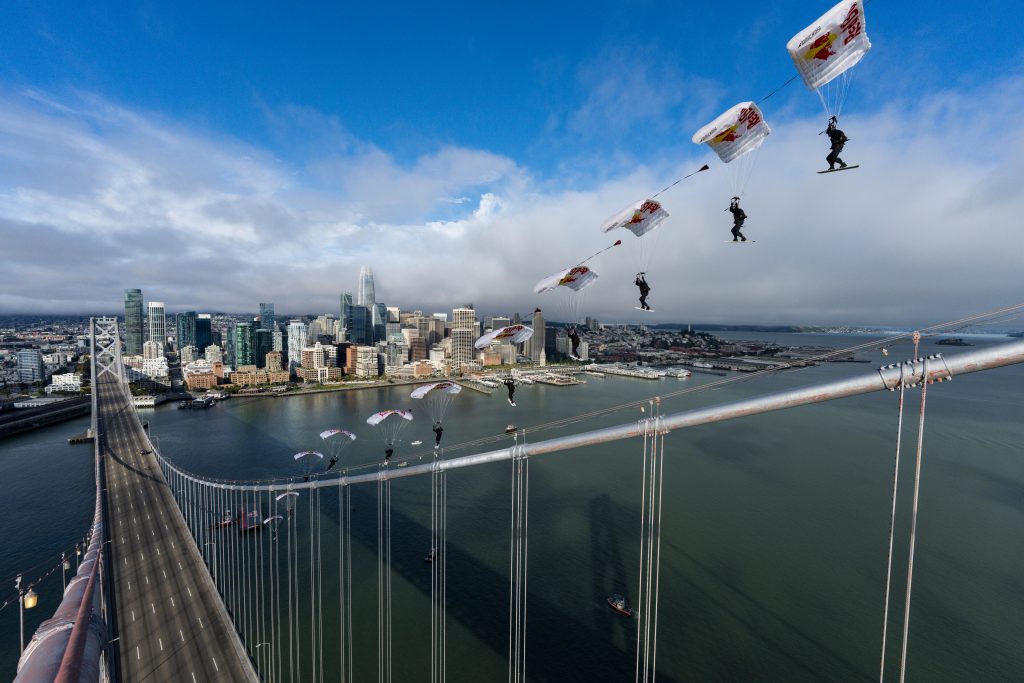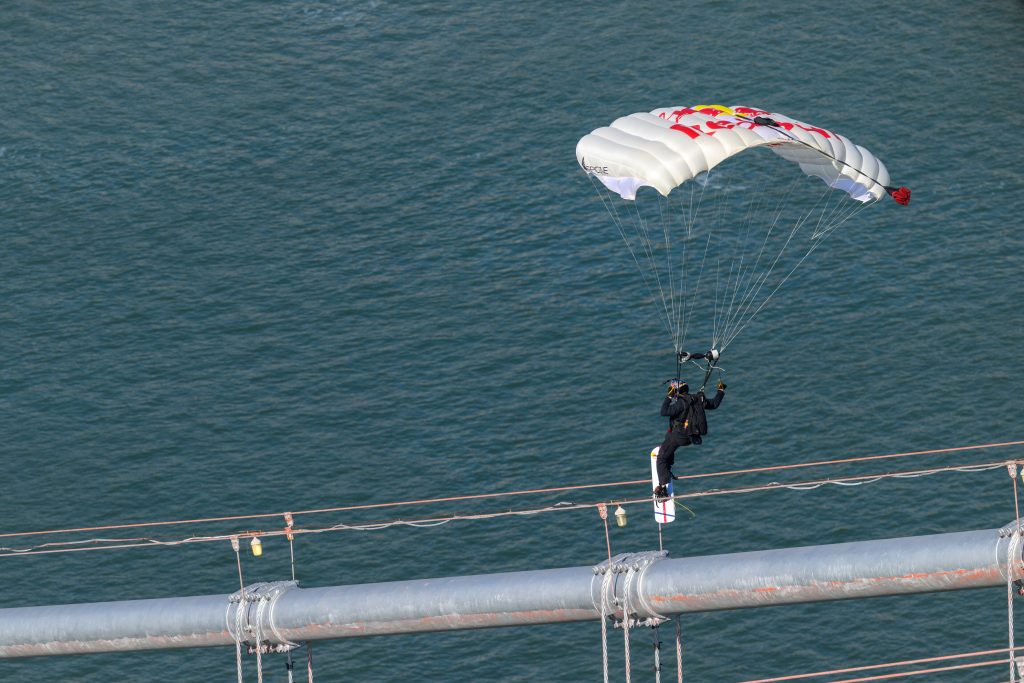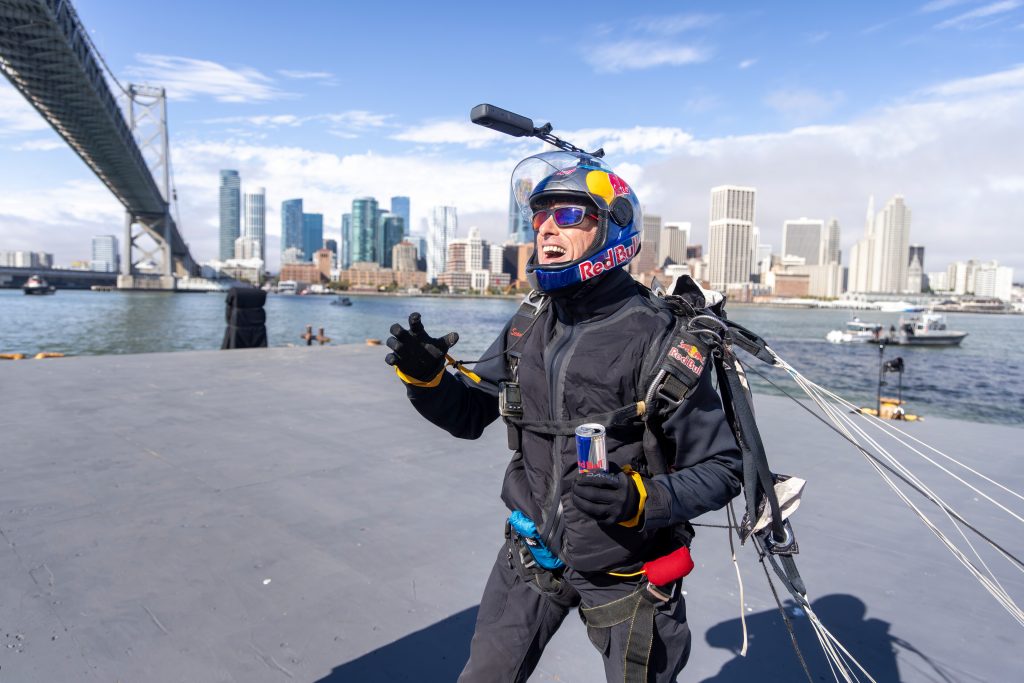Sean MacCormac Completes World-First Skysurf on San Francisco Bay Bridge Cables
The Red Bull Air Force Athlete Jumped from 5,500 Feet, Rode the Suspension Cables, and Landed Safely on a Floating Barge.

American skysurfing pioneer Sean MacCormac has become the first person to ride the suspension cables of San Francisco’s Bay Bridge.
MacCormac leapt from a helicopter 5,500 feet above the Bay before grinding the bridge cables on a custom board and landing safely on a floating platform below.
The 80/20 Snapshot:
- World-First Skysurfing Feat: MacCormac made history by skysurfing – a form of skydiving where athletes descend with a board strapped to their feet, performing aerial manoeuvres as though “surfing” through the air – along the suspension cables of San Francisco’s Bay Bridge. He completed the feat by riding the cables and landing safely on a floating barge in the Bay.
- Altitude & Descent: He jumped from a helicopter at 5,500 feet, navigating wind currents with precision to line up his descent with the bridge structure.
- Custom Equipment: MacCormac rode a one-of-a-kind board and wore high-performance garments designed by Prada Linea Rossa, merging skysurf engineering with cutting-edge materials.
- Preparation & Training: Months of planning, safety analysis and coordination with local authorities; multiple training runs on a 55-metre crane rig built to simulate the Bay Bridge cables.
- MacCormac’s Reaction: “This was probably the most intense, wildest project I’ve ever done [..] To be able to complete this project brings me an incredible sense of accomplishment,” said MacCormac.

Deep Dive:
The Red Bull Air Force athlete – who has completed more than 22,000 skydives and is regarded as one of the sport’s leading figures – jumped from a helicopter 5,500 feet above the Bay, strapped to a specialised custom board. He deployed his parachute shortly after exiting the aircraft and began his three-minute flight path toward the bridge cables, carefully adjusting for wind currents to maintain precision. As his board aligned with the cables, he rode along them, then executed a sharp right turn. MacCormac then descended the remaining 60 metres to the floating barge below.
MacCormac said: “This was probably the most intense, wildest project I’ve ever done. [..] I’ve never had that view before, and pretty sure no one else has either.” He continued: “To be able to complete this project brings me an incredible sense of accomplishment. We put such incredible focus, math and science into lining up the cable and landing safely on the barge.”
The feat, called Bridge Rider, took months of preparation, engineering analysis, and coordination with local authorities. To replicate the challenge of lining up with the bridge, he trained at Skydive Elsinore, a world-renowned skydiving site near San Diego, on a 55-metre crane rig designed to mimic the Bay Bridge cables. Multiple successful practice runs helped him refine his speed, precision and accuracy before attempting the real thing.
MacCormac explained: “We have a giant crane with two anchoring forklifts and with Eric, our math magician, we’ve been able to come pretty darn close to emulating the schematics of the bridge, so what we’re able to do is get some repetition and figure out what the best flightlines are and go through this whole process. It’s been really incredible and confidence-building, so we’ve crossed the rubicon of the unknown.”
Prada Linea Rossa, a partner in the project, supplied high-performance garments and equipment engineered for extreme conditions. The gear combined aerodynamic efficiency with comfort and mobility, while prioritising safety and freedom of movement.

MacCormac has long been at the forefront of skysurfing, always seeking to push the limits of what the sport can achieve. The idea for Bridge Rider originated during a lunch break while filming a BASE-jumping commercial in Los Angeles.
He recalled: “We had a lunch break and I was looking out over L.A., daydreaming about skysurfing.. and I just imagined this impossible grind where you could use the canopy to grind a rooftop or something. Seeing lines with this equipment that I wouldn’t have imagined otherwise. From there, it just kind of percolated into this.”
The American athlete’s experience extends beyond skysurfing. He has worked as a CIA civilian trainer, a Hollywood stuntman, and a civilian trainer for the US Navy and Air Force, combining his mastery of aerial dynamics with high-level tactical and stunt expertise.